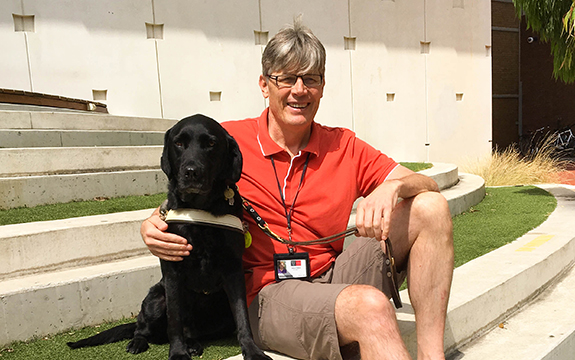Q&A: Garry Foran

In Summary
- A Q&A with Garry Foran, Swinburne University of Technology, orginally published in The Weekend Australian Magazine
At 12 you were diagnosed with a degenerative eye disorder. Did you know you would eventually go blind?
Yes, but the speed of that varies. As a teenager growing up in Sydney I had night-blindness, but I drove a car until I was 30 and I was able to pursue my PhD in chemistry and my career as a scientist. In 1992 I was one of the foundation team members of the Synchrotron project, which generates powerful X-rays to analyse the molecular structure of various substances, and I worked in that field for more than 20 years. But after I turned 40 my visual field began collapsing inwards and my capacity to operate precision equipment was really affected.
In 2010 you retired prematurely due to your blindness – that must have been distressing.
It was a dark period; there was a lot of self-pity and despair at what I’d lost, because one of the joys of working on the Synchrotron had been collaborating with scientists from different fields – drug design, the mining industry, earth sciences, optics. Colleagues in Japan offered me a desk role at a particle physics facility but after three years there I returned to Australia looking for a new direction.
So you decided to become an astrophysicist. Why?
Part of my make-up is to take on challenges. I’d always been interested in astrophysics and I still had a bit of vision in one eye; it wasn’t enough to analyse visual data but I’d been using screen-reading software for several years. I guess I had blind faith, no pun intended. In 2015 I heard a radio interview with some of the astrophysics team from Swinburne University; my wife Atsuko and I lived nearby. I approached them and they were fantastically supportive, particularly my supervisor, Professor Jeff Cooke.
Shortly after, you discovered you weren’t the world’s only blind astrophysicist…
In 2016 Jeff told me he’d seen a TedX talk by blind astronomer Wanda Diaz Merced, who had devised technology that translates digital data from telescopes into different sounds. Wanda was an inspiration and we are now collaborating on refining these sonification methods with the help of Jeff Hannam, a sound designer at RMIT University.
What’s the advantage of listening to data from telescopes rather than looking at it?
Humans respond faster to sound than to vision; also, our ears are very good at selecting unusual signals out of noise. One of my interests is studying violent explosions in distant galaxies – these can be very fast and transient events, so we often have many telescopes around the world sharing data as we race to observe them before they fade. Transforming the data into sound can speed up the process.
You also work with the ARC Centre of Excellence in Gravitational Wave Discovery…
Gravitational waves are caused by massive events such as collisions between neutron stars that cause a ripple to pass through space like the wave on a pond. By studying the light from these events millions of years ago, we hope to explain why the universe looks like it does and what might happen to it in the future.
What’s been the impact of your new career?
The ability to feel enabled rather than disabled has restored my balance in life – I owe a lot to the team at Swinburne and my wife. My vision is reduced to perceiving light and dark, and discerning shapes with one eye, but my trusty guide dog Trooper gets me around. I hope the research we’re doing into sound will ultimately help sight-impaired people in many walks of life, not just astrophysics.
Garry Foran is a PhD candidate at Swinburne University of Technology. This Q&A was orginally published by The Australian in The Weekend Australian Magazine, 12-13 October.

